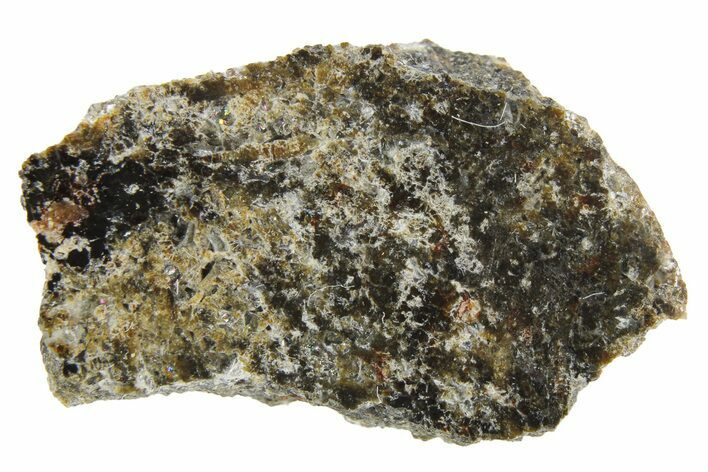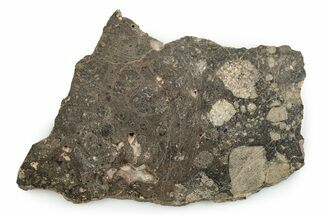This Specimen has been sold.
.65" Polished Martian Meteorite Slice (0.84 g) - NWA 14617
This is a .65" wide (0.84 grams) slice of the martian meteorite NWA (14714). It has been nicely cut into a thin slice and polished to a glossy finish on one side. It even displays some iridescence in translucent pockets throughout which can be seen in the photo above.
This specimen comes with an acrylic display case.
This specimen comes with an acrylic display case.
About Martial Meteorite NWA 14714
The meteorite known as NWA 14714 is a Martian shergottite meteorite purchased in January 2021 in northwestern Africa. It is identified as four identical stones with desert-weathered exteriors. Saw cuts reveal a medium-grained cumulate with light and dark crystals. The darker crystals coincide with areas that appear to be shock-darkened, and numerous black shock melt pockets are present. Its total known mass is about 4 kilograms.
Meteoritical Bulletin: Entry for The NWA 14714 Meteorite
The meteorite known as NWA 14714 is a Martian shergottite meteorite purchased in January 2021 in northwestern Africa. It is identified as four identical stones with desert-weathered exteriors. Saw cuts reveal a medium-grained cumulate with light and dark crystals. The darker crystals coincide with areas that appear to be shock-darkened, and numerous black shock melt pockets are present. Its total known mass is about 4 kilograms.
Meteoritical Bulletin: Entry for The NWA 14714 Meteorite
About Martian Meteorites (Shergottites)
Martian meteorites are rocks that formed on Mars before being ejected due to asteroid impacts, traveling through space and landing on Earth as meteorites. As you might expect, Martian meteorites are quite rare, representing less than 0.5 percent of all classified meteorites. The total mass of all known Martian meteorites is only several hundred kilograms. Superficially, Martian meteorites look very similar to igneous rocks on Earth, so nearly all have been identified from regions naturally devoid of rocks like sandy deserts (Sahara Desert and Oman) and the Antarctic ice sheets.
The achondrite meteorites are subdivided into three classes; shergottites, nakhlites, and chassignites, which together are referred to as the SNC group of meteorites. These meteorites are interpreted as Martian in origin because they have elemental and isotopic compositions similar to rocks and atmospheric gasses on Mars.
Roughly three-quarters of all Martian meteorites can be classified as shergottites. Shergottites are igneous rocks of mafic to ultramafic lithology that may have crystallized as recently as 180 million years ago. This is unusual, since most of the surface of Mars appears to be ancient, and the planet itself is rather small. Because of this, some believe that shergottites are actually much older. This "Shergottite Age Paradox" remains unsolved and is still an area of active research and debate.
Martian meteorites are rocks that formed on Mars before being ejected due to asteroid impacts, traveling through space and landing on Earth as meteorites. As you might expect, Martian meteorites are quite rare, representing less than 0.5 percent of all classified meteorites. The total mass of all known Martian meteorites is only several hundred kilograms. Superficially, Martian meteorites look very similar to igneous rocks on Earth, so nearly all have been identified from regions naturally devoid of rocks like sandy deserts (Sahara Desert and Oman) and the Antarctic ice sheets.
The achondrite meteorites are subdivided into three classes; shergottites, nakhlites, and chassignites, which together are referred to as the SNC group of meteorites. These meteorites are interpreted as Martian in origin because they have elemental and isotopic compositions similar to rocks and atmospheric gasses on Mars.
Roughly three-quarters of all Martian meteorites can be classified as shergottites. Shergottites are igneous rocks of mafic to ultramafic lithology that may have crystallized as recently as 180 million years ago. This is unusual, since most of the surface of Mars appears to be ancient, and the planet itself is rather small. Because of this, some believe that shergottites are actually much older. This "Shergottite Age Paradox" remains unsolved and is still an area of active research and debate.
TYPE
Basaltic Shergottite
LOCATION
Northwestern Africa
SIZE
.65 x .4", 0.1" thick, Weight: 0.84 grams
CATEGORY
ITEM
#256139
 Reviews
Reviews












